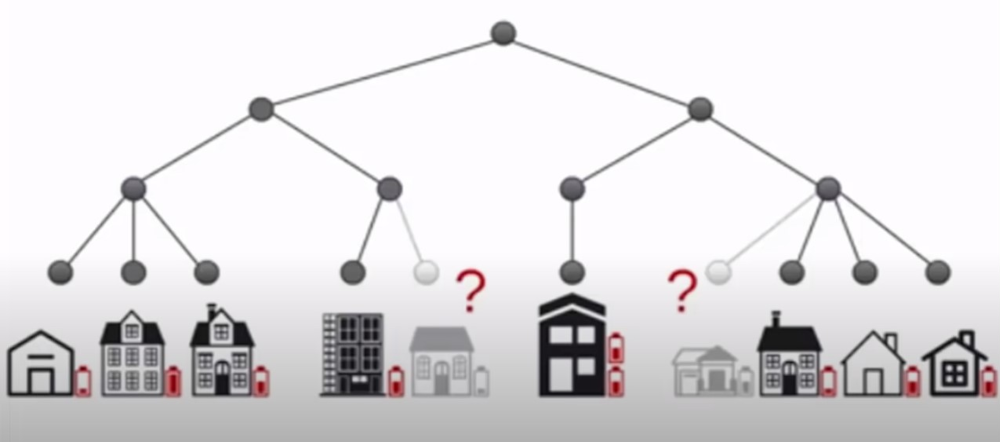
|

|

|

|

Tesla “Battery Day” Announcements Could Include Virtual Power Plants
A virtual power plant (VPP) is a cloud-based power plant that aggregates the capacities of independent energy resources at different locations into a power network. The concept of a VPP is different from the traditional utility model that has a centralized generator, transmission lines, and a distribution network. Under the traditional model, power flows in one direction. The growth of renewable energy has changed the dynamics of power generation. Once thought of as government-subsidized experiments, wind and solar power are now competitive with other energy sources. The growth of renewable power has increased the need for a system that can efficiently store energy. It has also spurred the growth of a market with dynamic pricing to reflect inconsistent supply and demand levels.
As renewable energy has grown, so too has distributed energy – small generation units that provide electricity on location, at times selling power back into the grid. Owners value on-site generation now only for economic reasons but also reliability reasons as power outages have increased. The result is an evolving system of hundreds of thousands of generation units in various locations and different cost structures. In theory, computer models could coordinate all these generations units, dispatching units through a coordinated, dynamic, real-time pricing market. In reality, VPP development is in the initial stages, although small experimental networks have been established in parts of Australia, Europe, California, and New York.
Where Does Tesla Come In?
In 2018, Tesla began installing Powerwalls in homes. Powerwalls are large lithium-ion batteries that can provide up to seven days of continuous power in the event of an outage. They often work in tandem with residential solar panels. Powerwalls can be installed in parallel to increase capacity. Powerwalls can be controlled remotely by a mobile app to optimize the cost of energy for customers with electric rates that vary depending on the time of day or the season. Typically, users will generate energy from solar panels during the day and store any excess power in the Powerwall. At night, when power prices are typically lower, the user will take electricity from the grid or draw down on the Powerwall battery. One use of the Powerwall would be to charge electric car batteries overnight.
Why are Electric Cars Important?
Tesla, as with other electric cars, requires enormous battery capacity, the company has hinted that it is making advances that could increase the capacity and storage life of the batteries. Elon Musk has indicated that it will hold a “Battery Day” perhaps in July, which has ignited speculation regarding their latest battery developments. Some believe Tesla will reveal a cheaper battery that will make electric cars as inexpensive as gas cars. Others expect Tesla to announce that it can make a battery that lasts a million miles or one that doubles the mileage range of cars. Others speculate that the next generation of car batteries will be powerful enough and last long enough that they can frequently cycle charges. The car batteries, then, would act in tandem or perhaps even as a substitute for Powerwalls, perhaps taking the next step of selling excess capacity back into the grid.
So How Would this Work?
Tesla car batteries would be charged overnight using solar power stored in a homeowner’s Powerwall. The owner then drives the car to work and plugs into an outlet that can either take electricity from the grid or give it back. With power prices typically higher during the day during times of peak demand and the car sitting idle, charging and uncharging the car each day would be economical. The owner can program base power requirements into a mobile app to make sure he has adequate power to drive home, run errands, etc. Car batteries could also take the place of backup generators. If there is a power outage, one could use the stored current in the battery to power up the Powerwall. And, since car batteries are mobile, they can charge up in areas with power and then relocate to areas without power. Imagine a rolling blackout that is accompanied by a rotating fleet of vehicles that power up at night and then transport to the next area where blackouts are planned. Add the mobility of cars to the mix and the utility system as we know it will have completely changed.
What Does This Mean for Utilities?
Utilities have undergone a process of deregulation that separates power generation from power distribution. Distribution will remain regulated as there will remain cost advantages to having one entity own and coordinate a distribution grid. Generation is more open to competition, including the use of battery power as a source of power “generation.” Electric utilities have long sought ways to reduce growing demand to forego building new, expensive power plants. Most utilities promote conservation even though it means less demand for their product. Existing power plants are typically low-cost producers that will continue to provide baseload demand. The idea of VPPs should not be viewed as competition for electric utilities but rather partners to them.
Suggested Reading:
Will Tesla’s Big Reveal Slash Electric Vehicle Prices?
Has Robinhood, the Online Brokerage Disruptor, Been Disrupted?
Will There be an Explosion in New Acquisitions
Enjoy Premium Channelchek Content at No Cost
Sources:
https://cleantechnica.com/2020/02/09/everything-you-need-to-know-about-the-powerwall-2-2019-edition/, Kyle Field, CleanTechnica, February 9th, 2020
https://www.youtube.com/watch?v=pP971PYzQJs, Battery Day is Coming, In Depth, May 15, 2020
https://www.eenews.net/stories/1063234625, David Ferris, E&E News, May 26, 2020
https://www.greentechmedia.com/articles/read/what-will-it-take-to-build-the-market-for-virtual-power-plants, Justin Gerdes, gtm, June 25, 2020
https://www.energy.gov/sites/prod/files/oeprod/DocumentsandMedia/ABB_Attachment.pdf, Aaron Zurborg, worldpower 2010